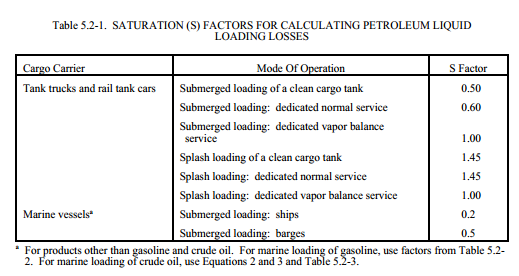When you rely on tanks to store, mix, or transport products and materials, you know just how complex it can be to measure and manage air emissions from any loading process. Every small detail about how you run your operations can affect the quantity of emissions you need to report and your permit requirements.
When a liquid material is being pumped into or out of a tank, this generates the primary form of emissions for oil & gas tanks emissions: working losses. The movement of the fluid, particularly the turbulence created from splashing in or out of fill pipes, creates airborne vapors that must be managed.
There are two main types of loading: splash loading and submerged loading. In short, splash loading pumps liquid into a tank from a position in the tank above the liquid level while submerged loading loads a tank from a fill pipe submerged to be nearly at the bottom of the tank.
Depending on which type you use, your emissions will differ. Knowing the difference is essential for accurately reporting your emissions.
That’s why we have developed this straightforward crash-course article in Splash Loading versus Submerged Loading - what they are, what the key differences are, and how each affects your reportable emissions.
Splash Loading Methods
 Splash loading is when you fill your tanks with material by lowering your fill pipe only partly into the destination cargo tank. This is known as the splash method because any liquids released through the fill pipe create a splash effect on impact with the tank and/or other materials in the tank.
Splash loading is when you fill your tanks with material by lowering your fill pipe only partly into the destination cargo tank. This is known as the splash method because any liquids released through the fill pipe create a splash effect on impact with the tank and/or other materials in the tank.
This significantly increased turbulence and vapor/liquid contact results in a higher level of vapor generation and loss. In fact, if the turbulence is great enough, liquid droplets of your material will be contained in the vented vapors, resulting in greater emissions and increased product loss.
Submerged Loading Methods
 Submerged loading occurs when you fill a tank using a line that is nearly or completely submerged below the surface of the liquid material being loaded. There are two styles of submerged loading: fill pipe method and bottom loading method.
Submerged loading occurs when you fill a tank using a line that is nearly or completely submerged below the surface of the liquid material being loaded. There are two styles of submerged loading: fill pipe method and bottom loading method.
In the fill pipe method, like with splash loading, a fill pipe is lowered into the tank and materials flow through. However, in submerged loading the fill pipe extends to almost to the bottom of the cargo tank in order to minimize any splash and resulting vapors from turbulence. In the bottom loading method uses a fill pipe permanently affixed to the cargo tank’s bottom, also to eliminate splash as materials are loaded.
Because a submerged fill pipe is below the liquid surface level, liquid turbulence is significantly controlled and a lower quantity of vapors are produced.
Loading Service Types: Dedicated Normal and Vapor Balance
There are two types of loading cargo tanks, both of which can occur as a splash loading or a submerged loading operation: Dedicated Normal Service and Vapor Balance Service.
Dedicated Normal Service
When cargo carriers are sometimes assigned to transport only one product for loading, this practice is known as dedicated normal service. Dedicated gasoline cargo tanks return to a loading terminal containing air fully or partially saturated with vapor from the previous load.
These cargo tanks can also be switch loaded - this means a nonvolatile product being loaded can be used to expel the vapors from a previous load of a volatile product from the cargo tank. However, switch loading is generally discouraged, and in some cases banned and fined, as it can cause a tank containing less combustible materials to contain highly combustible vapors. This can often result in higher safety and environmental risks, as transporters and handlers will treat the cargo tank as less combustible and risk than it may actually be from a chemical perspective.
Vapor Balance Service
ln a vapor balance service scenario, the cargo tank (most commonly a truck) retrieves the vapors displaced during product unloading at bulk plants or service stations. Those captured vapors are then transported back to the loading terminal. As a result, this cargo tank is saturated with organic vapors - this means there will be greater loading losses at the start of any submerged loading of the truck compared to “normal” loading service.
Estimating Emissions
According to the AP-42, section 5.2, emissions from loading operations can be estimated with the following calculation (with a probable error of ±30%):

Calculating emissions from loading requires you to include a saturation factor (S) representing the expelled vapor’s fractional approach to saturation. The saturation factor you must use is determined by the type of loading process used and the method of service. For example, a splash loading process done in the dedicated normal service method has an S factor of 1.45. The AP-42 table below details the S factors you should use for petroleum products:

Note that the AP-42 also lists other tables for S factors for marine vessels and other types of materials. Please ensure you refer to the original AP-42 document if doing your tank calculations by hand.
Other Calculation Considerations
Carrier History
The loading history of the cargo tank is another important factor in the type of emissions released. If the carrier had previously carried non-volatile liquid or has just been cleaned/degassed it will contain vapor free air. However, if the carrier had just carried gasoline and was not vented the air in the carrier tank will contain volatile organic vapors which will be expelled into the atmosphere during the next loading operation.
True Vapor Pressure (TVP)
One of the most notoriously difficult elements of tank emissions calculations is dealing with true vapor pressure values, since these are affected by ambient temperature. Although an underground tank will not experience the same temperature fluctuations as an exposed or above-ground tank, you should always be cognisant of the role temperature plays in the tvp of your materials. Many tank owners and operators have turned to a more automated system for calculating tvp and tank emissions simply because the the AP-42 calculations are more complex than they often appear.
The Importance of Modelling
Because you have many options for how to load and transport your materials and products between tanks, it can be difficult to track which S factors to use, in addition to tracking which materials have been loaded at which dates. The larger your business becomes, the greater risk your EH&S management team has for missing small details.
The best solution is to virtually model out each of your loading scenarios into a central platform so that you have a reliable database for which emission calculations to use, along with proper S factors, and an audit trail of which operations took place at any given time. The more you can automate the handling of data tracking and calculations (as opposed to spending time looking up charts doing emission estimations by hand), the more accurate your results will be and the more time you’ll have dedicated to actual EHS management.
Ask an ERA Expert:
Do you have any questions or concerns about the topic covered in this article? Want more insight? Now is your chance to ask one of ERA’s Environmental Specialists. Please leave your question or comment below and we’ll make sure one of our expert scientists responds.
All images taken from AP-42 section 5.2 from epa.gov
This Blog was Co-Authored By:


Tags:
Air Management
September 8, 2014
Comments